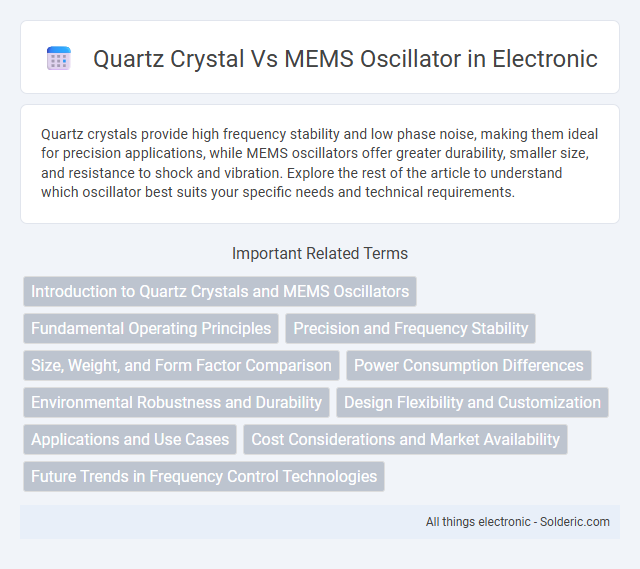Quartz crystals provide high frequency stability and low phase noise, making them ideal for precision applications, while MEMS oscillators offer greater durability, smaller size, and resistance to shock and vibration. Explore the rest of the article to understand which oscillator best suits your specific needs and technical requirements.
Comparison Table
| Feature | Quartz Crystal | MEMS Oscillator |
|---|---|---|
| Frequency Stability | High (+-10 ppm typical) | Moderate to High (+-20 ppm, can achieve +-5 ppm) |
| Size | Larger, bulkier | Compact, chip-scale |
| Shock & Vibration Resistance | Moderate; fragile | High; rugged design |
| Power Consumption | Higher | Lower |
| Temperature Range | Wide (-40degC to 85degC typical) | Wide, often wider with compensation |
| Manufacturing & Cost | Complex, higher cost | Mass-producible, lower cost |
| Environmental Impact | Uses quartz crystal, limited | Silicon-based, CMOS compatible |
| Applications | Traditional timing, telecom, GPS | Wearables, IoT, mobile devices |
Introduction to Quartz Crystals and MEMS Oscillators
Quartz crystals operate as highly stable frequency control devices using the piezoelectric properties of quartz to generate precise oscillations. MEMS oscillators utilize microelectromechanical systems technology to produce accurate timing signals with enhanced resistance to shock and vibration. Both quartz crystals and MEMS oscillators serve critical roles in electronics requiring reliable frequency sources, with quartz known for long-term stability and MEMS for miniaturization and robustness.
Fundamental Operating Principles
Quartz crystals operate based on the piezoelectric effect, where mechanical vibrations generate precise oscillations at a natural resonant frequency, offering superior frequency stability and low phase noise. MEMS oscillators rely on microelectromechanical systems that use miniature vibrating structures fabricated via semiconductor processes, allowing for integration and robustness in a smaller footprint. Both technologies convert mechanical vibrations into electrical signals, but quartz crystals depend on bulk crystal resonances, while MEMS oscillators utilize flexural modes in silicon structures.
Precision and Frequency Stability
Quartz crystal oscillators provide superior precision and frequency stability due to their high Q-factor and minimal temperature-induced frequency drift, making them ideal for applications requiring long-term stability. MEMS oscillators leverage advanced semiconductor fabrication techniques to achieve good stability with faster warm-up times and better shock resistance, though their frequency accuracy typically remains slightly lower than quartz crystals. Recent advancements in MEMS technology have narrowed the gap, enabling frequency stability within a few parts per million over temperature variations.
Size, Weight, and Form Factor Comparison
Quartz crystals typically have a larger size and heavier weight compared to MEMS oscillators, making MEMS devices more suitable for compact and lightweight applications. MEMS oscillators offer a smaller form factor, often measured in millimeters, which allows for easier integration into modern miniaturized electronic devices. Your choice of oscillator should consider the space constraints and weight limitations of your specific application to optimize performance and design efficiency.
Power Consumption Differences
Quartz crystals typically consume less power than MEMS oscillators, making them more efficient for battery-powered devices. MEMS oscillators, while offering advantages in size and robustness, often draw higher current due to their active circuitry. Evaluating power consumption differences helps optimize Your device's energy efficiency based on application requirements.
Environmental Robustness and Durability
Quartz crystals offer superior environmental robustness due to their inherent stability under extreme temperature and humidity variations, making them highly durable in harsh conditions. MEMS oscillators provide enhanced shock and vibration resistance because of their solid-state design, outperforming quartz crystals in rugged, high-impact environments. You can choose MEMS oscillators for applications demanding compactness and mechanical resilience, while quartz crystals remain preferred for long-term precision and stability.
Design Flexibility and Customization
MEMS oscillators offer superior design flexibility and customization compared to quartz crystals due to their manufacturability using semiconductor processes, allowing easy integration with other ICs and tailored frequency outputs. Quartz crystals have fixed resonant frequencies determined during manufacturing and require physical trimming to alter characteristics, limiting customization options. MEMS devices enable rapid prototyping and adaptation to specific application needs, making them ideal for diverse electronic systems demanding precise timing control.
Applications and Use Cases
Quartz crystals excel in applications requiring ultra-high frequency stability, such as precision timing in telecommunications, GPS systems, and aerospace navigation. MEMS oscillators are favored in rugged, space-constrained environments like automotive electronics, IoT devices, and consumer electronics due to their durability and integration capabilities. Your choice depends on the need for robustness and miniaturization versus absolute frequency accuracy.
Cost Considerations and Market Availability
Quartz crystal oscillators typically have lower unit costs due to established manufacturing processes and high-volume production, making them economically favorable for mass-market applications. MEMS oscillators, while higher in initial cost, offer benefits like smaller size and better environmental robustness, leading to potential savings in system-level design and reliability. Your choice may depend on balancing upfront costs with long-term availability and performance requirements, as MEMS technology is gaining traction but quartz remains widely available.
Future Trends in Frequency Control Technologies
Quartz crystal oscillators continue to dominate precision frequency control with stability and low phase noise, but MEMS oscillators are rapidly advancing due to their smaller size, lower power consumption, and enhanced resistance to shock and vibration. Future trends indicate increased integration of MEMS oscillators in IoT devices, automotive systems, and 5G infrastructure, driven by their compatibility with CMOS processes and cost-effectiveness. Your choice of frequency control technology will likely shift towards MEMS solutions as manufacturers prioritize miniaturization and robustness without compromising performance.
Quartz crystal vs MEMS oscillator Infographic

 solderic.com
solderic.com